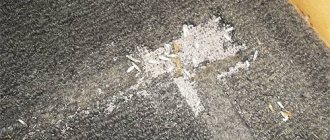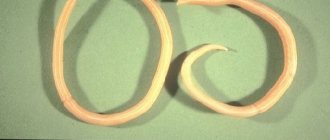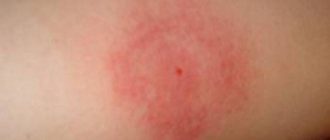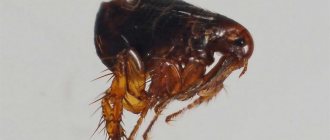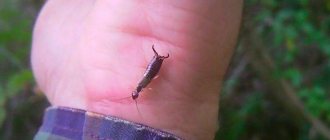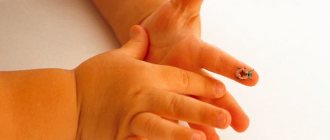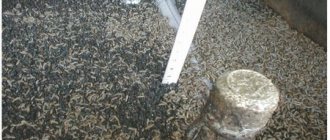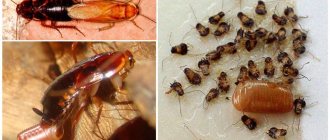Where do flies lay their eggs?
Females initially worry about future offspring.
Therefore, flies lay eggs where the larvae can fully feed and develop immediately after birth, since without food they die after 2 days. In nature, this is usually organic waste of a liquid consistency, since the mouthparts of maggots are not designed for solid food. At home, the fly tries to lay eggs on human food.
Receptors on the legs, which act as an organ of touch, help the insect find the optimal place for its offspring. Then the fly uses its proboscis to check the consistency and taste of the product, and only after that it lays eggs.
Contaminated Meat
Suitable for this:
- meat;
- fish;
- fruits;
- vegetables;
- offal;
- cottage cheese;
- cheese.
Ready-made meals based on cereals can also serve as food for offspring. In order for an insect to lay eggs, it is quite enough to leave food on the table for a short time during the warm period of the year.
The most effective methods of combating fly larvae
The destruction of larvae can be carried out using chemicals - in case of severe contamination of the territory - and folk methods.
The latter are recommended for use when the spread of larvae is insignificant.
Chemicals
Insects prefer to lay eggs in places where there are rotting organic remains.
Effective chemical agents in this case are drugs from the group of larvicides.
The destruction of larvae must begin with the treatment of the most likely habitats.
- liquid waste;
- waste collection areas;
- cesspools.
It is mandatory to disinfect the soil at the base. This approach will ensure the destruction of larvae and pupae buried in the ground.
To destroy maggots, sanitation begins in May. In regions where heat arrives earlier, it is advisable to carry out treatments as early as April.
The following types of larvicides are used to treat liquid waste:
- 0.3-0.5% disecryl - aqueous solution;
- 0.2% trochlovos – aqueous solution;
- 1% karbofos;
- 2% chlorophos - aqueous solution;
- 0.5% dichlorvos - aqueous solution.
For sanitation it is necessary to use only freshly prepared compounds.
Recommendations for processing that increase its effectiveness will be as follows:
- It is necessary to dissolve chemicals in warm water with constant stirring;
- chemical consumption rate - 200-1000 ml per square meter;
- processing is carried out periodically: two to five times within 30 days.
The frequency of sanitization is determined by the climatic conditions of the area and the number of larvae: the hotter and drier it is outside, the more often it is necessary to kill the parasites.
It is advisable to spray working solutions using sprayers.
If rooms, in particular basements, need treatment, then the floors must first be completely cleared of debris.
Then spray all visiting surfaces - walls, ceilings, floors
Particular attention should be paid to waste bins
To prevent the breeding of flies in the garden, the following means can be used to treat manure:
- Inkstone. 800 grams of product must be mixed in 10 liters of warm water. Spray the biomaterial with the composition.
- Boric calcium and borax. For 1 kg of borax, 1.224 kg of the second component is taken. The composition needs to be poured into 1 cubic meter of manure and spilled with water.
- Cheremitsa. You need to prepare a 5% aqueous solution from the plant powder and use it for pouring.
- Quicklime.
- Carbolic-sulfur mixture. You need to combine 1 part sulfuric acid and 3 parts carbolic acid.
Traditional methods
Traditional methods of killing fly larvae will also be effective.
They are used when there is a need to destroy fly larvae at home.
Boiling water
At home, flies can lay eggs in the trash can, as well as in sewer pipes if there are remains of rotting organic matter there.
A good result can be achieved by using boiling water for processing. Application scheme:
- In a large container you need to boil water well.
- Empty the bin of trash. Rinse it thoroughly with boiling water. To enhance the result, first add a little vinegar essence to it. Then it won't attract any more flies.
- To destroy the larvae in the sewer, the prepared boiling water must be poured into the kitchen sink.
You should use boiling water with vinegar once a week.
This will prevent the appearance of maggots.
Alternatively, to increase the effectiveness of boiling water, you can add a 2% aqueous solution of liquid soap or baking soda to it.
Prevention measures
The appearance of fly larvae can be prevented.
Prevention measures may include:
- Keeping the house clean. Products that have expired must be disposed of immediately and not allowed to sit in the trash.
- Regular inspection of vegetable stocks in the cellar. They should not rot, as they can be used by flies to organize masonry.
- Improvement of the area around cesspools and street toilets. The entire distance of 1.5 meters around must be concreted or covered with asphalt.
To repel flies and prevent their reproduction, you can plant elderberry bushes and bird cherry trees around the house. They repel flies well.
Video: How to get rid of flies in your house forever
https://apest.ru/muhi/o-muhah/yajca-i-lichinki-muh/
https://notklop.ru/muhi/2-fakty/22-yajca-i-lichinki-muh/
Classification of larvae
There are several types of maggots:
- Maggots are larvae laid by the blue carrion fly. They develop in rotting meat or fish, and a few minutes are enough for a fly to fly to the smell. These maggots reach a length of 15 mm.
- Gozzer is the larva of black-headed blue meat flies. Reaches sizes up to 20 mm and very quickly passes into the pupal stage.
- Gordinies are the larvae of gray blowflies, grow up to 25 mm, and pupate very quickly.
- Pinka is the larva of a green blowfly. Small maggots, not exceeding 10 mm in size.
- Fifa is the larva of a fly of the Lucilia species. Frost-resistant maggots no more than 12 mm long.
Gray blowfly
This fly is also called a sarcophagus. She is carrion. This is a large fly, its length reaches 25 millimeters. Gray blowflies are, as the name implies, gray in color with a darker checkered or line pattern, with a yellowish-white head “divided” by a black stripe. The eyes are red, and there are white longitudinal lines on the belly. The body shape is oblong, the abdomen is covered with large setae,
Gray blowflies are rare guests in a human home and appear there only if they have something to profit from there. The sense of smell of these flies is very developed, and they are able to smell the smell of rotting meat at a very long distance. Moreover, they only need to touch the surface of the meat for many small worms to immediately begin to move on it.
The larva of this fly is characterized by extraintestinal digestion. Sometimes she is able to feed on the larvae of other insects or practice cannibalism. The blowfly larva lives on carrion for up to 10 days, after which it moves into the soil, where it turns into a pupa, and then into an adult fly.
The pupa of a blowfly can hibernate; for example, the pupae of some species of sarcophagus are able to “sleep” through the entire winter and turn into an adult only in late spring.
The blowfly feeds on the nectar of flowers, and at the same time pollinates them, carrying pollen on its shaggy legs.
The attitude towards gray blowflies, as well as other carrion species, cannot be unambiguous. Being carriers of infectious diseases, they also serve as a kind of orderlies in nature. And forensic criminologists are able to determine the time of death by the age of the larvae in a decomposing corpse.
This is a beautiful fly of a glossy emerald color with smoky wings that have a faint openwork pattern. The length usually does not exceed 8 mm. It has large reddish eyes, a rounded belly and white cheeks.
The habitat of the green blowfly is places of all kinds of sewage, decomposing animal corpses, manure, waste, but sometimes they are also found in flowering plants that have a strong aroma. The food consists of rotting organic matter, where it lays its eggs.
One female is capable of laying approximately 180 grayish or light yellow eggs, which she tries to hide in carrion as deep as possible. The larvae are born after 6-48 hours and continue to develop there for another 9 days. They then move into the soil to develop into a pupa. Depending on weather conditions, an adult fly is formed within 10-17 days.
Types of larvae
There are about 3.5 thousand species of flies in nature, but only a few of them penetrate into a person’s home. Finding favorable conditions here, they lay eggs, from which larvae subsequently emerge.
Maggot
In addition to the larvae of ordinary houseflies, the following species can be found in an apartment:
- Maggot. The length of the insect reaches 15 mm. This species is the offspring of the blue carrion fly. Maggots can appear in meat and fish.
- Gozzer. This is the larva of the black-headed blue fly. Characterized by rapid pupation. The size of the insect at the last stage of development reaches 20 mm.
- Gordini. The maggot of a gray blowfly, the size of which reaches 20-25 mm. The larva quickly pupates.
- Pink. This species is the offspring of the green blowfly. The body length of the larvae does not exceed 10 mm.
- FIFA. Lucilia fly maggot. Belongs to the category of frost-resistant species. The length of the larva does not exceed 12 mm.
What you need to know about flies
There are more than 4 thousand species of this insect in the world. All of them, without exception, can cause discomfort and cause some harm to humans, but their role is important in the food chain of many animals and especially birds. In the territory of the former CIS, exophilic and endophilic flies are most often found. Both of them can live in a person’s home, causing considerable discomfort.
The danger may come not from the insects themselves, but from the fly larvae.
For example, in the Wohlfarth fly, which we are used to seeing near agricultural buildings, the larvae are carnivorous, and in the most advanced cases they can lead to disability. Green, shiny flies are no less dangerous; they are called meat flies.
There are many species of these insects that live near humans, which can also bring certain benefits.
Tahina is considered to be such a species - this insect destroys caterpillars in gardens and fields. But the ktyr, with its sharp sting and poison, destroys mosquitoes, midges and other blood-sucking insects. There are blood-sucking representatives of the genus Diptera, which cause certain harm to people and animals. They are called bloodsuckers of horses, dogs and deer. The bite of such individuals cannot go unnoticed - the fly digs its sharp proboscis into the body and drinks blood. Their larvae, accordingly, are carnivorous and require a living organism as a home for development.
The optimal environment for laying eggs and inhabiting flies are places favorable for the development of bacteria, infections and other negative factors - these are landfills, dung beetles, toilets and garbage cans. It is this unsanitary environment that is favorable for the reproduction of these insects.
The developmental stages of these arthropods are fleeting; in literally 15-20 days, the fly turns from an egg into an adult, capable of laying new eggs. It is worth saying that in one clutch it is capable of producing from 100 to 150 eggs.
Fly larvae appear on the fifth day from small white eggs, the size of which is no more than 1.2 mm. After a week, these white worms change their appearance and turn into a kind of pupa. Their skin takes on a dark brown color and becomes significantly rougher, which provides protection for the insect while it is inside. After 10 days, an adult emerges from the pupa, which is able to begin mating and after 2-3 days lay new eggs.
Some species can be called viviparous, since they carry eggs within themselves and insect larvae are born, which are at the stage of pupal formation.
The fly can lay larvae anywhere - it can be manure, food or lost food, garbage, or even a wound on the animal’s body. It all depends on the type of dipteran and its mode of life. The fly larvae, hoverflies, are capable of eating more than 2 thousand aphids over the entire period of their development.
Fly eggs on food
The fly feeds on the juices of rotten plants, ripe fruits, and blood. The larvae need a moist environment and the availability of food. Therefore, flies lay eggs on products that begin to deteriorate, there is blood on them, and signs of rotting.
- fruits;
- vegetables;
- meat;
- offal;
- cheese;
- sweets;
- milk products;
- ready-made dishes from vegetables, cereals.
In order for a fly to lay eggs on meat, cottage cheese, cheese, and other products, they must be left on the table or in another place without proper storage. In everyday life, this situation occurs very often, so insect clutches are present almost everywhere.
Prevention and safety measures against flies
The basic rule of hygiene always comes first, which concerns not only washing your hands, but also the proper handling of food before eating it. It is important to keep household items and utensils in proper condition. If food remains on the table in the summer, it must be covered with a special lid, mesh, or placed in an airtight container.
If flies enter the house, it is necessary to carry out special treatment using repellents. If an egg laying site is discovered, it must be thoroughly treated with chlorine-containing agents and chemical aerosols against these insects.
It is advisable to install mosquito nets on windows and doors - this will prevent dipterans from entering the house.
It is necessary to take care of the area where the garbage container is located - this area must be kept clean. Outdoor toilets must be equipped with special outlets for water flushing and basic cleaning of the premises. For barns and other premises intended for keeping livestock, there are special traps for winged pests. These are sticky tapes, hanging feeders with a sticky bottom that catch insects.
These measures will help protect livestock and prevent mass breeding of flies indoors.
Follow basic hygiene rules, concentrate on the condition of products and methods of storing them, carry out the necessary treatment of premises from harmful arthropods - all this will help protect your home and the people living in it from discomfort and the danger of contracting infectious diseases.
What happens if you eat fly eggs depends on the type of the body’s immune system and the individual characteristics of the digestive system. In most cases, nothing bad happens. But there are varieties of flies whose larvae live under human skin and cause myiasis. Their removal requires surgery and can have serious consequences.
Dangers of swallowing flies
Low acidity, damage to the mucous membrane of any part of the digestive tract and a tendency to trap air during food intake lead to the fact that the insect remains alive for some time after ingestion, and can lay eggs on the way to the stomach.
As a rule, insects can lay eggs in a few seconds, and there are some species that spit eggs into the eyes, mouth and nose of an animal on the fly in order to introduce the parasite into the body of the “breadwinner”.
Also, if flies, eggs or larvae get into the mouth and further into the digestive tract, even if they die, they can infect a person with many diseases and pests that they carry on their body. Salmonella, cysts, worm eggs (roundworms, trichinella and others) often reach humans due to flies.
Family Flesh flies
This family includes more than two thousand species. They are found mainly in the northern hemisphere, in temperate climate zones. In hot climates there are not so many of them.
The blowfly is mostly gray in color, but other colors are also found. Some species are quite large, their length can reach more than two centimeters, but there are also small ones - no more than six millimeters. The larvae of these flies usually develop on rotting meat or other organic matter. There are blowflies that lay eggs in other insects, wounded animals, and even humans.
There are viviparous blowflies that lay larvae in a decomposing corpse.
Bacterial poisoning
Flies may visit multiple food sources throughout the day, and they may carry harmful bacteria that they have collected from human or animal waste. They can transfer these bacteria to the food people eat.
Larvae that develop in contaminated food can ingest these bacteria. People who eat these contaminated foods or maggots are also exposed to the bacteria and may feel unwell.
Salmonella and E. coli are examples of bacteria that flies and maggots can transmit to humans.
Salmonella
Salmonella is one of the most common causes of foodborne illness. Symptoms of salmonella infection include:
- abdominal cramps
- nausea and vomiting
- diarrhea
- fever
Symptoms usually begin 12 to 72 hours after a person ingests the bacteria, and the illness usually lasts 4 to 7 days.
People with salmonella poisoning often get better without treatment. However, frequent vomiting and diarrhea can lead to severe dehydration and sometimes hospitalization. Therefore, it is important for people with salmonella poisoning to drink plenty of fluids, including clear broths and fruit juices, to replace lost fluids and electrolytes.
E. coli poisoning
There are many different strains of E. coli. While most strains are harmless, some can cause food poisoning.
Here are the symptoms of E. coli poisoning:
- stomach cramps
- diarrhea that may contain blood
- vomit
- slight increase in body temperature, usually below 38.3°C
These symptoms usually develop 1–10 days after bacteria enter the digestive tract and may last 5–7 days.
E. coli infections can vary in severity from very mild to severe, and can sometimes even be life-threatening. As with salmonella poisoning, people need to drink plenty of fluids to prevent dehydration
Unfavorable outcome, or myiasis
Some myiases are caused by insect larvae, which usually develop in rotting organic matter. This type of disease is called accidental. Such flies and larvae enter the human body with food, clothing or household items.
Swallowed eggs can dissolve in hydrochloric acid, or they can remain intact and be absorbed into the blood. If they enter the bloodstream, they will travel through the vessels to any part of the body. The most dangerous cases are when fly eggs enter the brain, heart or liver. Such cases are quite rare, but still they should not be excluded.
And from the eggs, larvae emerge, which gnaw holes in the host’s body and also send waste products to the body. As the larvae move through the body, the patient feels severe itching, discomfort, and pain. Also, already matured larvae, not eggs, can get inside.
Intestinal myiasis
When a person becomes infected with fly larvae, intestinal myiasis occurs. The larvae live on or inside a person and survive by feeding on his tissues.
Intestinal myiasis is a type of myiasis that can occur when a person eats a fly larva that survives in the gastrointestinal tract. Some people with intestinal myiasis do not experience any symptoms and may only realize they are infected after noticing larvae in their stool.
However, here are some symptoms of intestinal myiasis that you may experience:
- abdominal pain
- nausea and vomiting
- itching in the anus
- bleeding from the rectum
Myiasis is not common in developed countries and occurs primarily in tropical and subtropical countries, including Africa and South America. However, a person may develop myiasis as a result of traveling to these countries.
Myases
Serious diseases are caused by gray larvae. Eggs enter the body with food, in the presence of diseases of the digestive tract, weak immunity, they are not digested and enter the systemic bloodstream. Over time, they are localized in different internal organs.
The larvae never pass through the human body, but during their life activity they can cause significant harm. Swallowing eggs due to their small size is quite easy, so you need to pay special attention to where you eat, the quality of the food, and eat only fresh foods. Eggs are laid only on products that begin to deteriorate or storage conditions are violated.
Yulia Borta, AiF: Alexander Markovich, flies are carriers of pathogens of intestinal infections. Isn't that the end of their harm?
Alexander Bronstein:
No. For example, green blowflies, which are ubiquitous, try to lay their eggs in meat and fish. Most often, such infection occurs in places where meat and fish are openly sold or when they lie in the air. In food, fly eggs develop into larvae (known to fishermen as maggots), which can be swallowed by humans.
Often no deterioration in well-being occurs; the larvae are excreted from the body intact. It's unpleasant, that's all. But if a lot of them get into the intestines, then this can provoke cramping pain in the abdomen, nausea, vomiting, diarrhea, and itching. A regular saline laxative is prescribed as treatment.
Yu.B. "AiF": If there are no flies in the room, then there is nothing to be afraid of?
A.B.:
Not always. I have had patients become infected by inhaling earth dust containing fly larvae. A pregnant Muscovite swallowed them while replanting indoor plants. Another patient suffered “at work.”
Due to the nature of his work, he had to grind soil samples with his bare hands to determine its quality. It is not known exactly where the soil came from - perhaps from greenhouses or imported from other countries. Therefore, it is recommended to work with the soil with gloves, or even better - in a respirator, and pregnant women generally refrain from such activities.
What to do if you eat a fly larva?
Accidental ingestion of the larvae usually does not cause long-term harm. However, if a person ingests a fly larva while eating spoiled food, they may suffer from food poisoning. Symptoms of food poisoning can range from very mild to severe, and can sometimes last for several days.
Here are the groups of people at higher risk of developing food poisoning:
- Small children
- aged people
- people with weakened immune systems
For people who develop severe vomiting and diarrhea as a result of food poisoning, it is important to drink plenty of fluids to prevent dehydration.
Consequences
If a person accidentally swallows an adult fly or eggs of a fly, then usually nothing bad happens. Insects consist of protein and chitinous shell, which are easily broken down by gastric juice or excreted naturally.
Some people have an individual reaction in their digestive tract to fly eggs. The painful condition manifests itself in the form of:
- stomach ache;
- nausea;
- vomiting;
- stomach upsets.
If symptoms persist for more than 2–3 hours, and health worsens, then call a doctor as soon as possible for the victim.
The real danger to people is the larvae of gray blowflies, which cause myiases - parasitic diseases of the skin, intestines, stomach, respiratory system, vision, and hearing. However, such a lesion is typical for countries in Africa and South America, where this type of fly lives.
Under normal conditions, even if you swallow a fly, its eggs or larvae, it will not have any serious consequences for the body.
In shorts and on the beach
Yu.B. "AiF": Some flies bite quite noticeably. Is it dangerous?
A.B.:
The bites of most flies, with the exception of the tsetse fly, are unpleasant but not dangerous, which cannot be said about their larvae. If there are wounds, abrasions, or ulcers on the body, then flies attracted by the smell can lay eggs there. The larvae that hatch from them eat dead tissue, pus, and then fall off the skin, i.e., in some way clean the wound. And in the century before last, doctors, for lack of antibiotics, even specially planted maggots into wounds for speedy healing. However, there are fly larvae that can easily penetrate into intact skin and eat healthy tissue, sometimes causing irreversible defects on the body.
Yu.B. "AiF": Where do these "cannibals" live?
A.B.:
Mainly in the countries of South and Central America, in particular in Brazil, Mexico, Argentina, etc., as well as in Africa. For example, one of my patients, vacationing in Madagascar, caught the larvae in his stomach - he was doing push-ups on the beach.
After a business trip to Guinea, a Muscovite discovered boils on her buttocks. There were fly larvae in them. She was drying clothes on the open terrace.
Apparently, flies laid eggs on the fabric, and when she put on her panties, the larvae burrowed under her skin.
Yu.B. "AiF": How to protect yourself from them?
A.B.:
, be sure to wear shoes, do not sunbathe on the sand. Try not to dry clothes under palm trees or bushes - it is better in the open sun in a horizontal position.
But, alas, this does not provide 100% protection. So the main thing is to notice skin lesions in time and contact a specialist as quickly as possible.
The life of a modern person is not without its proximity to dangerous and harmful insects. Adults bring a lot of discomfort, but much worse is the fly larva, which may go unnoticed. At first glance, this is a harmless creature, and it is difficult to imagine what harm it can cause.
In fact, it is the common fly that most often carries various types of infections that are dangerous to human health and sometimes even human life.
It will be useful to know how to protect yourself and your loved ones from these pests, what methods of dealing with them are the safest and most effective.
Do people intentionally eat fly larvae?
Many people in countries outside Europe and North America eat insects. Scientists estimate that there are about 2,000 species of edible insects. Like the insects themselves, the eggs and larvae of some species are edible.
Casu marzu is a Sardinian cheese containing thousands of larvae. During the early stages of cheese production, the cheesemaker removes the outer rind, which encourages flies to enter and lay eggs. For several months, the larvae feed on rotting cheese. The larvae's excrement gives the cheese its unique, pungent flavor.
Due to the health risks of eating live larvae, the European Food Safety Authority has banned the sale of cas marzu. However, a small number of Sardinian farmers continue to produce cheese for personal consumption.
Food for larvae
Depending on the species of dipteran, its maggot will have certain food preferences. There are flies whose larvae spend their entire stage, from eggs to adults, inside a cheese wheel or in a dung heap, or even worse, in the body of a living creature. The larvae feed on organic matter that is at the stage of decomposition - these are rotting foods, carrion and decaying meat; they also eat the larvae of other types of insects: caterpillars, beetles, ants, snails and grasshoppers.
Fighting uninvited guests
A large fly buzzing under the ear can not only cause a relative inconvenience, but is also a carrier of a dangerous disease. They can infect both food and introduce infection directly into the human blood. Tuberculosis and cholera are a few of the diseases that flies can infect humans.
The main principle of dealing with them is maintaining cleanliness. After all, as already mentioned, flies perfectly smell food and fly towards it. Empty the trash can regularly, clean up after pets, do not leave food exposed, equip windows with protective nets - these are simple ways that can greatly make a person’s life easier.
After all, despite being ordinary, it is capable of causing us many problems even in its short life. Even if it does not carry the disease, it can be very annoying because it does not have enough insight to understand that it is not welcome here and look for a quieter place. No matter how many times you chase her away, she will come back again and again.
In addition, as she flies around the room, she marks everything with her secretions. Scientists have calculated that one fly can “check in” in at least fifty different places per day. And each of them is a real breeding ground for microbes. So in the fight against flies, the rule that “cleanliness is the key to health” works more than ever.
By the way, not only blowflies, but also small midges that bother you outdoors can also be the causative agent of serious diseases. It causes various conjunctivitis and is the cause of many intestinal diseases.
Summarize
- For most people living in temperate regions, accidental consumption of a maggot is unlikely to cause harm.
- People may experience temporary bouts of food poisoning if they eat infested maggots or spoiled food containing them. However, most cases of food poisoning go away without treatment within a few days.
- If you experience severe symptoms after accidentally ingesting maggots, you should see a doctor.
Sources
- https://WikiParazit.ru/babochki-i-moshki/chto-budet-esli-sest-lichinku-muhi.html
- https://klopkan.ru/muhi/chto-budet-esli-sest-yaytsa-ili-lichinki-muhi/
- https://izbavitsya-ot-vrediteley.ru/proglotit-muhu.html
- https://www.magicworld.su/zdorove/1067-chto-budet-esli-s-est-lichinku-mukhi.html
- https://komarmuha.ru/chto-budet-esli-proglotit-muhu
[collapse]
